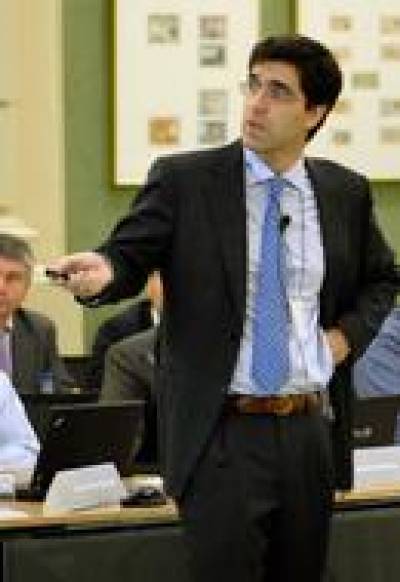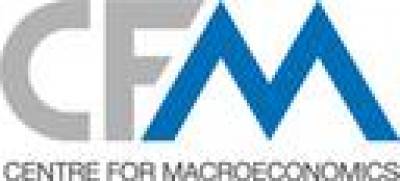
Masterclass
Jesus Fernandez-Villaverde (University of Pennsylvania)
Monday 14th - Tuesday 15th March 2016
Location: Charter Suite, CILIP, 7 Ridgmount Street, London WC1E 7AE
 |
 |
 |
Sponsored by CfM, ADEMU and Cemmap
Programme
| Monday 14th March | |
| 08:30-09:00 | Registration and coffee |
| 09:00-10:30 | Session 1: Empirical evidence: time-varying volatility in the time series and cross-section |
| 10:30-11:00 | Coffee break |
| 11:00-12:30 | Session 2: How to build a DSGE model with uncertainty shocks |
| 12:30-13:30 | Lunch |
| 13:30-15:00 | Session 3: Solution methods |
| 15:00-15:30 | Coffee break |
| 15:30-17:00 |
Session 4: The econometrics of uncertainty shocks |
| Tuesday 15th March | |
| 09:00-09:30 | Morning coffee |
| 09:30-11:00 |
Session 5: The econometrics of uncertainty shocks (continued) |
| 11:00-11:30 | Coffee break |
| 11:30-13:00 | Session 6: Applications |
Masterclass organised by Morten Ravn (UCL)
- Outline
-
This series of lectures will introduce students to the recent literature on the macroeconomics of uncertainty shocks (also known as volatility shocks).
Macroeconomics is concerned with the dynamic effects of shocks. For instance, the real business cycle research program originated with an investigation of the consequences of changes in productivity. Later, the new generation of monetary models of the late 1990s and early 2000s was particularly focused on shocks to monetary policy. In open macroeconomics, considerable attention has been devoted to shocks to the interest rate (Mendoza, 1991) or to the terms of trade. Similar examples can be cited from dozens of other subfields of macroeconomics, from asset pricing to macro public finance: researchers postulate an exogenous stochastic process and explore the consequences for prices and quantities of innovations to it.
Traditionally, one key feature of these stochastic processes was the assumption of homoscedasticity. More recently, however, economists have started to relax this assumption. In particular, they have started considering shocks to the variance of the innovations of the processes.
A first motivation for this new research comes from the realization that time series have a strong time-varying variance component. The most famous of those episodes is the great moderation of aggregate fluctuations in the U.S. between 1984 and 2007, when real aggregate volatility fell by around one third and nominal volatility by more than half. A natural mechanism to generate these changes is to have shocks that also have themselves a time-varying volatility and to trace the effects of changes in volatility on aggregate dynamics.
In these lectures, we want to study time-varying volatility with the help of DSGE models, the workhorse of modern macroeconomics and the most common laboratory for policy evaluation.
How do we incorporate time-varying volatility in the models? How do we solve models with this time-varying volatility? How do we take them to the data? What are the policy implications of volatility?
Examples of papers in the area include Bloom (2009), Fernandez-Villaverde, Guerron-Quintana, Rubio-Ramirez, and Uribe (2011), and Fernandez-Villaverde, Guerron-Quintana, Kuester, and Rubio-Ramirez (2015). Some more methodological papers are Caldara, Fernandez-Villaverde, Rubio-Ramirez, and Yao (2012) and Fernandez-Villaverde, Guerr_on-Quintana, and Rubio-Ramirez (2015). - Pre-requisites
-
A familiarity with a first-year graduate school sequence in macroeconomics is required. Some experience with DSGE models can be helpful, but it is not crucial.
- References
-
Bloom, N. (2009): “The Impact of Uncertainty Shocks," Econometrica, 77, 623-685.
Caldara, D., J. Fern_andez-Villaverde, J. F. Rubio-Ramirez, and W. Yao (2012):
“Computing DSGE Models with Recursive Preferences and Stochastic Volatility," Review of Economic Dynamics, 15, 188-206.
Fernandez-Villaverde, J., P. Guerron-Quintana, K. Kuester, and J. Rubio-Ramirez (2015): “Fiscal Volatility Shocks and Economic Activity," American Economic
Review, 105(11), 3352-84.
Fernandez-Villaverde, J., P. A. Guerron-Quintana, and J. F. Rubio-Ramirez
(2015): “Estimating Dynamic Equilibrium Models with Stochastic Volatility," Journal of
Econometrics, 185, 216-229.
Fernandez-Villaverde, J., P. A. Guerron-Quintana, J. F. Rubio-Ramirez, and
M. Uribe (2011): “Risk Matters: The Real Effects of Volatility Shocks," American
Economic Review, 101, 2530-2561. - Registration form
-
Registration for this event is now closed.
- PhD Delegate Reimbursement
-
If you are a student UK Higher Education delegate travelling within the UK (from outside Greater London) to attend this masterclass, you may be eligible for a contribution towards your accommodation and travel (maximum contribution £175). These funds are only available if no other funds are accessible. Please ensure that you ask your Tutor or Head of Department to confirm your status by completing their details.
To claim for your expenses, you must complete this form and return it to us with your departmental letter and proof of purchase (train / bus tickets and receipts for accommodation).
If you have any further queries, please contact the Event Manager, Nirusha Vigi
 Close
Close

